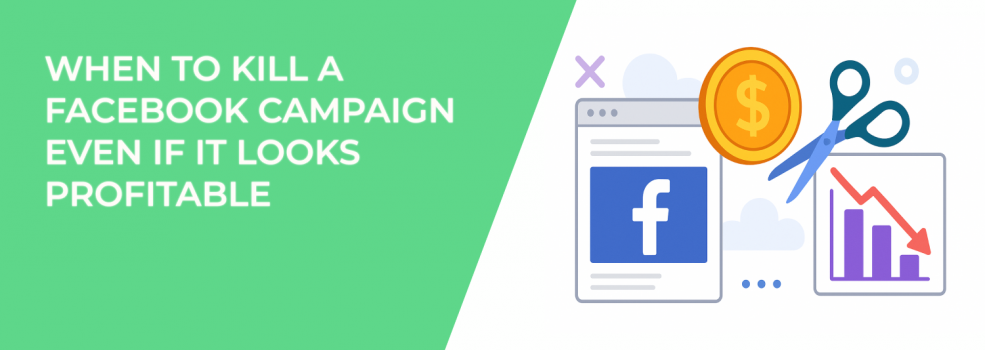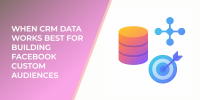A profitable campaign isn’t always a good campaign. Surprised? You’re not alone. Many advertisers fall into the trap of focusing on surface-level metrics — like ROAS or low CPL — while missing deeper issues that slowly eat into their long-term performance.
This article covers the not-so-obvious reasons you might want to shut down a Facebook campaign — even when the numbers look good on paper.
Profit Isn’t the Only Metric That Matters
When a campaign is generating results, the obvious instinct is to let it run. But advertising isn’t just about today’s numbers.
Performance has layers. And sometimes, the more strategic move is to cut a campaign before it declines — even if it seems profitable at the moment.
Here are six clear signals that it’s time to pause or kill a campaign, no matter what the top-line metrics say.
1. Cost per Acquisition Is Creeping Up
A campaign might start out strong — for example, $12 per purchase. But over the next couple of weeks, that number drifts upward. Suddenly you’re paying $18, then $22, even $25.
At first glance, it might still seem acceptable, especially if your product margins are healthy. But this kind of slow CPA increase is often a sign of audience fatigue or inefficient scaling.
Here's what to watch for:
-
CPA has increased more than 30% compared to your starting benchmark.
-
Performance has declined consistently over a 7–10 day period, not just due to a short-term fluctuation.
-
Other ad sets with similar targeting are showing better results.
If any of these are true, it's a sign the campaign may have peaked — and you're now paying a premium for lower quality conversions.
If you're also noticing delivery issues, you might be running into a deeper algorithm problem. This guide explains how to fix “Ad Set May Get Zero” warnings — a common hidden roadblock to scaling.
2. You’re Attracting the Wrong Type of Customer
This is one of the most expensive mistakes marketers make — running a campaign that brings in users who don’t stick around.
Imagine you're getting 400 leads per week. Sounds great, right? But none of them reply to your follow-up emails. Or they convert to customers, but churn after one payment cycle.
If your top-of-funnel performance is strong but the back end tells a different story, it’s time to dig deeper.
Check these downstream signals before trusting your front-end results:
-
Churn rate — Are these customers sticking around for more than one transaction or month?
-
Customer lifetime value (LTV) — Is the average value per user declining?
-
Email open/click rates — Are your leads actually engaging with your follow-up campaigns?
-
Support tickets or refund requests — Are new customers satisfied with what they bought?
If quality is low, no amount of upfront profitability will make the campaign worth keeping. If you’re not sure your audience is even the right one, revisit your targeting strategy using this step-by-step guide to defining your audience.
3. You’re Relying Too Much on One Creative or Audience
Sometimes a single ad or audience segment drives the bulk of your results. That’s a good thing — until it isn’t.
When over 80% of your spend goes toward one creative, you're building your campaign on a shaky foundation. Facebook's algorithm may reward it at first, but performance usually deteriorates as frequency increases and saturation sets in.
Red flags to look for:
-
One ad or audience accounts for more than 70–80% of your total budget.
-
You haven’t tested any fresh creatives in over two weeks.
-
Performance starts to drop slightly, even though you’re still getting conversions.
Don't wait for creative fatigue to wreck performance. This guide to spotting ad fatigue early will help you take preemptive action before it’s too late.
4. Ad Frequency Is Rising — and Results Are Slipping
Let’s say your campaign frequency has climbed to 4.5. That means users have seen the same ad more than four times on average.
Even if conversions are still trickling in, this is often the beginning of the end. People tune out, relevance scores drop, and your CPMs start to rise.
If you see these patterns, it's time to take action:
-
CTR is falling despite steady impressions.
-
You’re getting more “Hide Ad” feedback in your account quality metrics.
-
CPMs are climbing without a clear reason (like audience size shrinking).
Learn how to exit the learning phase faster so new creatives and audiences don’t stall your campaigns as you test.
5. The Market Has Shifted, and You Haven’t Adjusted
Seasonal demand, competitor activity, or sudden news events can all shift buying behavior.
Just because a campaign worked last month doesn’t mean it’s aligned with what’s happening now. Holding onto outdated messaging or offers can drag down your results — and prevent budget from being reallocated to more relevant strategies.
Ask yourself these questions:
-
Has competition in this ad category increased?
-
Has your audience’s intent or motivation changed?
-
Are external factors (e.g., seasonality, holidays, economic events) affecting demand?
If so, it may be time to reallocate budget to new strategies. Here's a good reference on scaling campaigns without losing ROAS that includes pivot strategies for mid-flight campaigns.
6. You Could Be Getting Better Results Elsewhere
Sometimes the campaign isn’t failing. It’s just not winning enough.
If you have multiple campaigns running, compare their performance side by side. You may find that your budget is stuck in a “good enough” campaign, while another one with better potential is underfunded.
Here’s how to evaluate opportunity cost:
-
Is this campaign performing significantly below others in the same account?
-
Are other campaigns hitting a higher ROAS or lower CPA with similar targeting?
-
Is this campaign consuming a disproportionate share of budget relative to its results?
In cases like this, even a profitable campaign should be paused or cut — because keeping it live is costing you in unrealized performance elsewhere.
The Takeaway
Facebook Ads aren’t just about running what works. They’re about scaling what works best — and removing the rest before it becomes a liability.
Don’t wait for a crash. If a campaign shows signs of fatigue, misalignment, or inefficiency, it’s smarter to shut it down proactively and reinvest that budget in something fresher.
Watch the signs. Look beyond ROAS. And remember: in a dynamic ad environment, the best move is sometimes subtraction, not addition.

